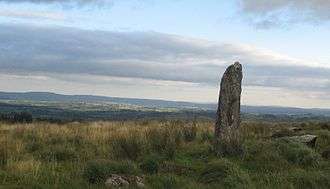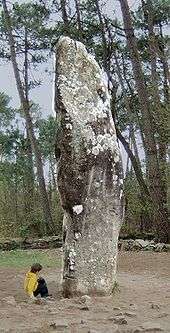Menhir
A menhir (from Brittonic languages: maen or men, "stone" and hir or hîr, "long"[1]), standing stone, orthostat, or lith is a large man-made upright stone, typically dating from the European middle Bronze Age. They can be found solely as monoliths, or as part of a group of similar stones. Menhirs' size can vary considerably, but they are generally uneven and squared, often tapering towards the top.

They are widely distributed across Europe, Africa and Asia, but most numerous in Western Europe; particularly in Ireland, Great Britain, Brittany and France, where there are about 50,000 examples,[2] while there are 1,200 menhirs in northwest France alone.[3] Standing stones are usually difficult to date, but pottery, or pottery shards, found underneath some in Atlantic Europe connects them with the Beaker people. They were constructed during many different periods across pre-history as part of the larger megalithic cultures in Europe and near areas.
Some menhirs have been erected next to buildings that often have an early or current religious significance. One example is the South Zeal Menhir in Devon, which formed the basis for a 12th-century monastery built by lay monks. The monastery later became the Oxenham Arms hotel, at South Zeal, and the standing stone remains in place in the ancient snug bar at the hotel.
Where menhirs appear in groups, often in a circular, oval, henge or horseshoe formation, they are sometimes called megalithic monuments. These are sites of ancient religious ceremonies, sometimes containing burial chambers.[4] The exact function of menhirs has provoked more debate than practically any other issue in European pre-history. Over the centuries, they have variously been thought to have been used by Druids for human sacrifice, used as territorial markers, or elements of a complex ideological system, or functioned as early calendars.[5] Until the nineteenth century, antiquarians did not have substantial knowledge of prehistory, and their only reference points were provided by classical literature. The developments of radiocarbon dating and dendrochronology have significantly advanced scientific knowledge in this area.
The word menhir was adopted from French by 19th-century archaeologists. The introduction of the word into general archaeological usage has been attributed to the 18th-century French military officer Théophile Corret de la Tour d'Auvergne.[6] It is a combination of two words of the Breton language: maen and hir. In modern Welsh, they are described as maen hir, or "long stone". In modern Breton, the word peulvan is used, with peul meaning "stake" or "post" and van which is a soft mutation of the word maen which means "stone". In Germany and Scandinavia the word Bauta is used (e.g.de:Bautastein and no:Bautastein) and this occasionally makes its way into English with the term "bauta stone".

History
Almost nothing is known of the social organization or religious beliefs of the people who erected the menhirs. There is not even any trace of these people's language; however we do know that they buried their dead and had the skills to grow cereal, farm and make pottery, stone tools and jewelry. Identifying their uses remains speculative. Until recently, menhirs were associated with the Beaker people, who inhabited Europe during the European late Neolithic and early Bronze Age—later third millennium BC, c. 2800–1800 BC. However, recent research into the age of megaliths in Brittany strongly suggests a far older origin, perhaps back to six to seven thousand years ago.[7]
Many menhirs are engraved with megalithic art. This often turned them into anthropomorphic stelae, although images of objects such as stone axes, ploughs, shepherd crooks and yokes were common. With the exception of the stone axe, none of these motifs are definite, and the name used to describe them is largely for convenience. Some menhirs were broken up and incorporated into later passage graves, where they had new megalithic art carved with little regard for the previous pictures. It is not known if this re-use was deliberate or if the passage grave builders just saw menhirs as a convenient source of stone (Le Roux 1992).
During the Middle Ages, standing stones were believed to have been built by the giants who lived before the biblical flood. Many of the megaliths were destroyed or defaced by early Christians; it is estimated that some 50,000 megaliths once stood in Northern Europe, where almost 10,000 now remain.[8]
Four menhirs and nearly 1,000 small and big dolmens were found in India at the Pothamala hills at the Kerala-Tamil Nadu border by a group of researchers in Kerala.[9]
Geographical distribution
See also
- Carlin stone
- Carnac stones
- Cove (standing stones)
- Cromlech
- Deer stone – Megalith
- Dolmen – Type of single-chamber megalithic tomb
- Fulacht fiadh
- Gowk stane
- Henge – Type of Neolithic earthwork
- Inuksuk – Type of manmade stone landmark or cairn
- Kigilyakh
- Ley line – Straight alignments between historic structures and landmarks
- List of largest monoliths – Wikipedia list article
- Moai – Monolithic human figures on Easter Island
- Napakivi
- Nature worship
- Obelisk – Tall, four-sided, narrow tapering monument which ends in a pyramid-like shape at the top
- Obelix – Cartoon character in the French comic book series Asterix
- Orthostat
- Statue menhir
- Stone circle
- Stone row
- Stone ship
- Stone slab
Notes
- Anon. "Menhir". The Free Dictionary. Farlex, Inc. Retrieved 15 December 2010.
- Greene, Janice (January 2006). Strange But True Stories. ISBN 1-59905-010-2. Retrieved 25 August 2011.
- Oliphant, Margaret "The Atlas Of The Ancient World" 1992 p. 81
- Chris Roberts, Heavy Words Lightly Thrown: The Reason Behind Rhyme, Thorndike Press,2006 (ISBN 0-7862-8517-6)
- Patton, Mark. "Statements in Stone: Monuments and Society in Neolithic Brittany". (New York), Routledge, 1993. P. 4.
- Landru, Philippe (23 August 2008). "LA TOUR D'AUVERGNE (Théophile Malo Corret de la Tour d'Auvergne : 1743-1800)". Retrieved 24 January 2018.
- Aviva, Elyn; White, Gary. "Mysterious Megaliths: The Standing Stones of Carnac, Brittany, France". World and I, Vol. 13, October 1998.
- Olsen, Brad (February 2004). "Carbnac". Sacred Places Around the World: 108 Destinations By Brad Olsen. Consortium of Collective Consciousness. p. 232. ISBN 1-888729-10-4. Retrieved 21 February 2010.
- https://www.thenewsminute.com/article/20-foot-menhir-found-idukki-may-reveal-prehistoric-human-activity-106239
References
- Le Roux, C. T. 1992. "The Art of Gavrinis Presented in its Armorican Context and in Comparison with Ireland." in Journal of the Royal Society of Antiquaries of Ireland vol. 122, pp 79–108.
- Mohen, Jean-Pierre (2000) [1998]. Standing Stones: Stonehenge, Carnac and the World of Megaliths. ‘New Horizons’ series. Translated by Baker, Dorie B.; Baker, David J. London: Thames & Hudson. ISBN 0-500-30090-9.
External links
| Wikimedia Commons has media related to Menhirs. |
- Dolmens, Menhirs & Stones-Circles in the South of France – Menhirs of the "Cham des Bondons"
- New Theory – Henges – Engineering in Prehistory
- Rows of menhirs in Russia, South Ural
- List of menhirs and their related stories in Czech Republic
- Ancient Europe Placemarks Google Earth file downloads.
- Skela menhirs in Ukraine (in Ukrainian)